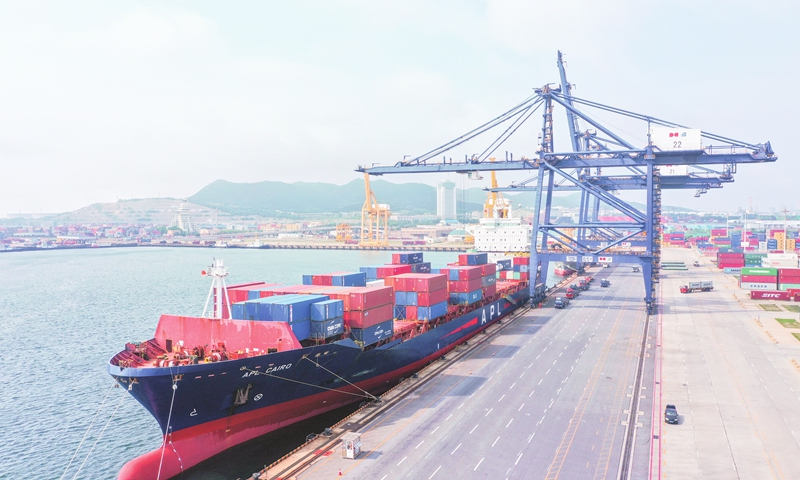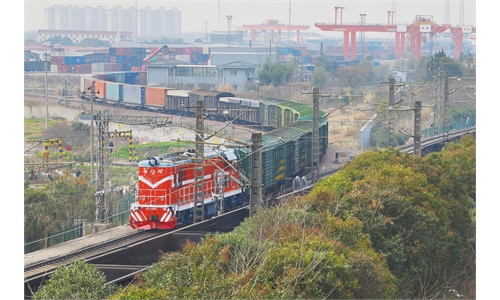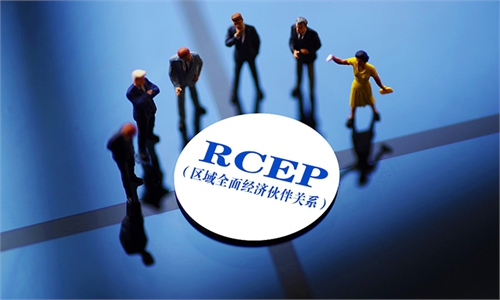
A ship docks at the port of Dalian in Northeast China's Liaoning Province on July 3, 2022. Photo: cnsphoto
Chinese localities have recently ramped up support measures to boost foreign trade in the second half of 2022, including new models to help enterprises maintain overseas markets, while exploring new clients, at a time when face-to-face contact has been constrained amid the COVID-19 pandemic.
China is scheduled to release trade data for the first half of the year on Wednesday, which is expected to show solid recovery, but the external environment for China's exports remains challenging in the second half of the year.
Over the past week, local governments in North China's Hebei Province, East China's Anhui Province and Fujian Province, Southwest China's Chongqing Municipality, South China's Guangxi Zhuang Autonomous Region and other places have rolled out policies and support measures to stabilize foreign trade.
These measures are seen as follow-ups to measures released by the State Council, the cabinet, in early June to promote stable foreign trade.
East China's Zhejiang Province, for example, issued 10 measures on Monday to help enterprises, including organizing business charter flights and regular flights to ensure smooth entry and exit channels for business personnel. Enterprises are encouraged to explore overseas markets through new models such as "representative exhibition services."
The representative service mode means that only products will go abroad, while people stay at home. Enterprises can entrust foreign partners, overseas Chinese or third-party exhibition companies to represent them and participate in exhibitions. They can also communicate with customers online at the same time, a Shenzhen-based autopilot system supplier told the Global Times on Tuesday.
"We used such a model to participate in the CES 2022 in January in Las Vegas. We hired a professional booth team to show our products to visitors and we actually found new foreign customers," the supplier said.
Using representative services at trade fairs is a very good model, which should be expanded among enterprises, as it is the most feasible way to maintain and expand overseas markets under the current pandemic situation, Zhu Qiucheng, CEO of Ningbo New Oriental Electric Industrial Development, told the Global Times on Tuesday.
"E-commerce acceptance in foreign markets is much lower than in China; therefore, maintaining and developing overseas markets still requires on-site exhibitions. And there is no substitute for overseas trade fair participation," said Zhu, who has been in the foreign trade industry for more than 20 years.
On June 21, the local commerce bureau of Wenzhou in Zhejiang released a subsidy policy for local enterprises that will attend international trade exhibitions using representative services.
For enterprises participating in key international exhibitions supported by the municipal government, 70 percent of the booth fee will be subsidized, and 80 percent of the booth fee will be subsidized for exhibitions in countries and regions involved in the China-proposed Belt and Road Initiative. The maximum subsidy for each overseas booth will not exceed 25,000 yuan ($3,717), read a post on the municipal government's website.
Apart from overseas trade fairs, charter flights that allow enterprises to have face-to-face communication with their overseas partners are also important to maintain foreign trade, industry insiders said.
The first commercial round-trip charter flight took off from Zhejiang's Ningbo on Sunday, heading for Budapest, Hungary, carrying 36 entrepreneurs. Another chartered flight will take off from Ningbo to Milan on July 21.
"Ningbo is a pioneer of foreign trade in China. Amid the pandemic, Ningbo has taken the lead by sending chartered flights to open up overseas markets. It also greatly boosted the confidence of Ningbo traders and traders nationwide," said Zhu.
Ding Yandong, who is in charge of a Ningbo-based window and door manufacturing enterprise, was on the Sunday chartered flight.
At the beginning of this year, one of the firm's biggest clients in Poland was acquired, but due to difficulties in logistics and on-site communication, the "new" customer wanted to replace the Chinese supplier it had never met, according to Ding, who was quoted by local media ypstatic.
"This client places $1 million in orders every year, which contributes 40 percent of our profit margin. We were so worried that this year's order would be delayed," Ding said, describing the chartered flight as "hitting the spot."
Industry observers said that though China is going all out to boost trade, the second-half trade picture still depends on conditions in overseas markets, whose demand is decreasing amid economic recession and rising inflation.


